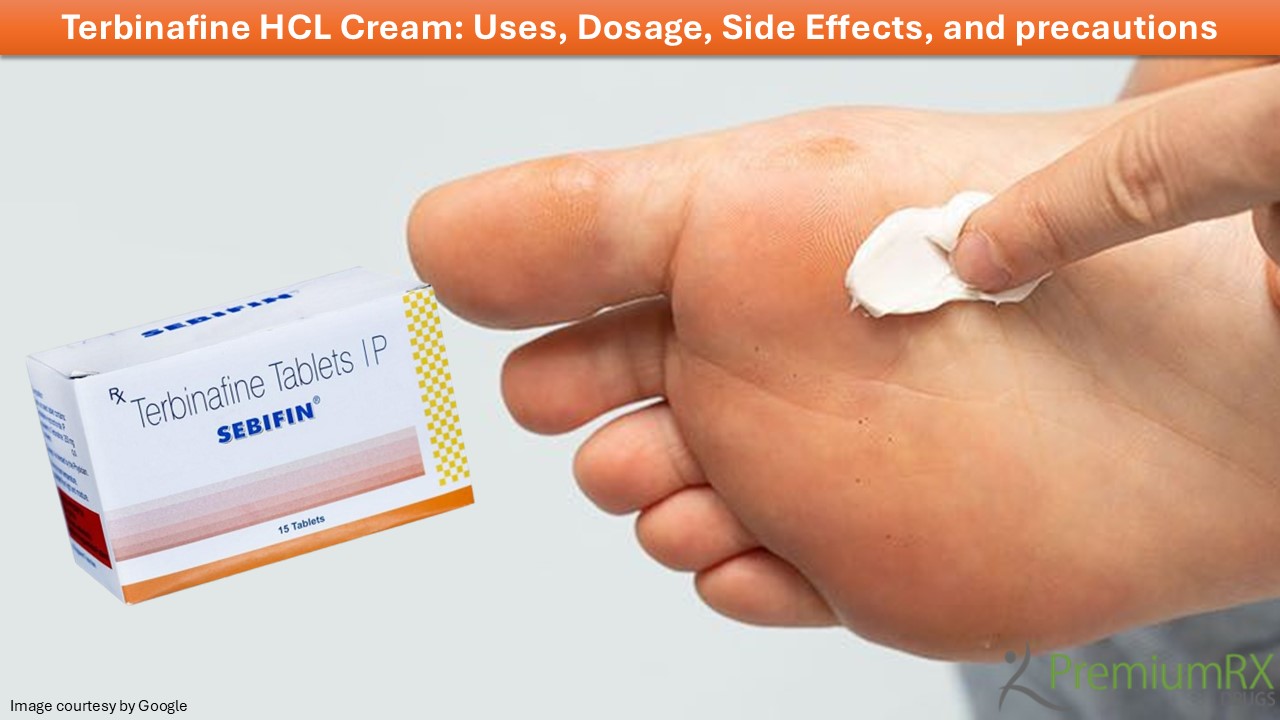Terbinafine HCl cream is a prescription medication for certain fungal skin infections. It can be applied once or twice daily to treat ringworm and yeast skin infections. Let’s briefly examine Terbinafine cream’s uses, side effects, and precautions.
About Terbinafine HCL
Terbinafine HCl is an antifungal agent used to treat many superficial fungal infections. It belongs to the allylamine class of antifungals and shows broad-spectrum activity against dermatophytes, yeasts, and certain molds. Terbinafine is a cornerstone in managing conditions like athlete’s foot, ringworm, and fungal nail infections (onychomycosis). It is a powerful medicine against fungal infections and is highly effective in treating various superficial fungal infections. Due to its ability to accumulate in keratinous tissue, it is very effective in treating nail and scalp infections. This is a very safe medicine, but its side effects should be taken care of, especially in case of liver disorders and particularly during long courses. This medicine provides rapid and effective relief from fungal infections when used as directed. This medicine can improve a patient’s quality of life, but it is always recommended to consult a doctor for personalized medical advice and a tailored treatment plan.
Terbinafine is a synthetic compound with a distinct structure, which enables it to target fungal cells. It contains an allylamine group, which is crucial for antifungal activity. The medicine exhibits a lipophilic nature, which helps it penetrate the skin’s outermost layer and accumulate in the skin, nails, and hair, providing long-lasting antifungal effects even after treatment is stopped.
Working of Terbinafine
Terbinafine works by blocking squalene epoxidase, an enzyme essential for synthesizing ergosterol, a key component of fungal cell membranes. Ergosterol is essential for maintaining membrane fluidity and integrity, and its depletion leads to compromised cell function. Additionally, the disruption of metabolism leads to the accumulation of a toxic intermediate called squalene, causing further damage to fungal cells. This dual action of the medicine effectively kills the fungi, distinguishing Terbinafine from many other antifungals that are only fungistatic (inhibiting growth without killing the organism).
Pharmacokinetics
Terbinafine is easily absorbed following oral administration, with peak plasma concentrations reached within two hours. It has a high bioavailability and enhanced activity when taken with food. It is extensively metabolized in the liver. The half-life of Terbinafine cream is approximately 36 hours, supporting once-daily dosing. This drug is excreted through urine, and some amount is also excreted through feces. Due to its high half-life, its effects will last for weeks after discontinuation, contributing to sustained antifungal effects.
Indications and clinical uses
Terbinafine HCL cream is prescribed for the treatment of a variety of fungal infections, including-
- Tinea infections (ringworm of the body)
- Ringworm of the foot (tinea pedis)
- Ringworm of the groin
- Tinea versicolor (also called sun fungus)
- Cutaneous Candidiasis
- Yeast Infections
Dosage and administration
Terbinafine HCL dosage depends on the form of administration and the type of infection. Topical Terbinafine is applied once or twice to the infected area. Its duration depends on the severity of the infection, and typically, it is prescribed for 1 to 4 weeks. The cream should be applied to clean, dry skin. It should be applied only to the affected and surrounding areas in a thin layer and then gently rubbed. If there are no visible improvements after two weeks of regular application, it is essential to consult a healthcare provider. It is essential to complete the course of therapy, even after symptoms improve, to prevent recurrence and the development of resistance.
Drug resistance
Terbinafine cream is very effective, but the development of antifungal resistance has become a major issue. Mechanisms develop due to mutations in the squalene epoxidase gene, which result in reduced drug binding. Dermatophytes generally show drug resistance.
Side effects of Terbinafine
Terbinafine cream is usually well-tolerated but may have some side effects, including severe ones. Common side effects include-
- Nausea, diarrhea, abdominal pain, and dyspepsia
- Rash, itching, and rare cases of urticaria
- Headache, dizziness, and taste disturbance (dysgeusia) are reported, particularly with oral therapy.
Serious side effects are:
- Liver enzymes may spike sometimes and can cause severe liver injury. Regular liver function tests are advised if you are on prolonged therapy.
- Allergic reactions, such as anaphylaxis and Stevens-Johnson syndrome, and other hypersensitivity reactions are rare but possible.
- Blood disorders, such as thrombocytopenia and neutropenia, are seen in rare cases.
Precautions
Terbinafine cream should be used with caution in the following circumstances:
- Pregnancy and Breastfeeding – This cream is excreted in breast milk; therefore, it should be used only after consulting a doctor and when necessary.
- Renal impairment – No specific dosage adjustments are required; however, use caution when using this medicine.
- Drug interactions – It can interact with drugs such as cyclosporine, certain antidepressants, and statins.
Inform your doctor if you use any other formulation or medicine to treat your skin infection.
Verdict!
Terbinafine HCL cream is an antifungal cream that interferes with the production of ergosterol, which the fungus requires to grow, and causes the build-up of another substance, squalene. These actions contribute to the fungus’s death and help eliminate the infection. Because fungal and yeast infections can be transferred from one person to another, it’s essential to keep your towel and avoid sharing personal items with others. To protect yourself from the recurrence of infection, wash your towel, clothes, and bedding frequently.
Marie
Latest posts by Marie (see all)
- Terbinafine HCL Cream: Uses, Dosage, Side Effects, and precautions - April 28, 2025
- Revize Micro Gel 0.025% | Uses, Price, Side effects - April 9, 2025
- What is Evalon Cream: How to Apply, Benefit, who Can Use - April 4, 2025




